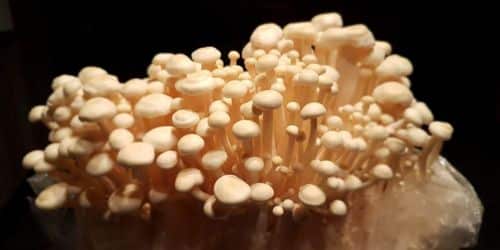People frequently believe that cultivating mushrooms necessitates specialized equipment and laboratory settings, and mushroom cultivation language can be scary. But don’t be alarmed. Growing your own gourmet mushrooms is simple and satisfying, and no expensive equipment is required. Beginners only need a mushroom growing kit, a thermometer, and a spray bottle to get started. The first thing that happens when you open your mushroom growth kit and start spraying the substrate is mushroom pinning.
Continue reading to find out what mushroom pinning is, what it looks like, how and when to start mushroom pinning, and even how to cope with the vexing side of pinning.
What is Mushroom Pinning?
Mushroom pinning is a phenomenon that occurs during the early stages of mushroom production. When a fungus has enough nutrients, certain environmental circumstances cause it to produce fruiting bodies, which we call mushrooms.
When this happens, the fungal mycelium alters its attention from growing to get additional nutrients to producing spore-producing fruiting structures. Pinning, pinhead initiation, knotting, pin set, and fructification are some of the names for this process.
It starts with hyphal knots formed by strands of mycelium made of hyphae, the hair-like cells that makeup mycelium. These hyphal knots eventually mature into primordia, or tiny mushrooms, which growers refer to as mushroom pins because they resemble pinheads.
Hyphal knots are the first observable stage in the development of a mushroom. But first, a significant component of the mushroom’s life cycle must occur.
What Does Mushroom Pinning Look Like?
The initial stage of mushroom pinning appears as tiny small bumps starting to grow on the surface of the mycelium covering your mushroom substrate. These lumps are caused by mycelium clumping together to produce hyphal knots.
When your mycelium has completely colonized the substrate, it becomes denser and creates white lumps or bumps, which indicates that the pinning process has begun. These hyphal knots or lumps continue to grow from the substrate’s surface and evolve into tiny matchstick-like primordia or mushroom pins.
In order to create the final product, a person’s life is a work of art. They no longer require cell division to expand once pinning is complete. Instead, they overwhelm the existing cells with water and nutrients, causing them to rapidly expand.
Not all of the mushroom pegs will mature into mushrooms. The fungus selects the healthiest, most viable pins, which then grow into adult mushrooms. This growth process distinguishes mushrooms from plants and animals and allows them to grow faster.
How to Initiate Mushroom Pinning
Some mushrooms, particularly many oyster mushroom strains, will start pinning as soon as they have colonized the substrate under the correct conditions.
Other varieties of mushrooms, on the other hand, may require more particular conditions to start pinning, such as:
- Lower temperatures, often around 53 to 64°F (12 to 18°C)
- High humidity, generally RH levels of 85% or higher
- Fresh air exchange and CO2 levels less than 1000ppm}
- Some indirect light
When you start initiating mushroom pinning, you have two goals. To begin, provide light and reduce CO2 levels to alert the mycelium that it has reached the surface. Second, to simulate autumn-like conditions in order to indicate to the mycelium that the environment is suited for fruiting. This is aided by lower temperatures and high humidity.
Depending on the sort of mushrooms you’re cultivating and the method you’re employing, pinning can begin in a variety of ways. If you’re growing mushrooms in bags, you may need to cut a hole, open the top of the bag, or, in the case of shiitakes, remove the grow bag completely and sprinkle the colonized substrate.
When growing mushrooms in buckets or containers, remove the lid or uncover the holes and spray the colonized substrate.
Whatever method you use, you must not only give fresh air and humidity, but you must also position your mushrooms in a location with the proper temperatures and lighting. For easy-to-grow mushroom species like oysters and shiitake mushrooms, a space on a kitchen counter near a window would suffice.
A mushroom fruiting chamber, on the other hand, is the greatest approach to assure optimal pinning and growing conditions for fussier species or cultivating mushrooms year-round.
Monotubs, shotgun fruiting chambers, and Martha grow tents are all low-cost do-it-yourself solutions for beginning mushroom producers. A walk-in mushroom growth tent or grow room with shelves or hanging bags is also required if you wish to start a mushroom farm.
When to Initiate Pinning?
When your substrate is ready for fruiting conditions, visual confirmation is the best method to tell. There is no set period for incubation, and various factors, like as temperature fluctuations and spawn rate, can influence how long it takes the mycelium to colonize your substrate.
Wait until hyphal knots and primordia grow on the substrate before introducing fresh air and autumn-like conditions. If you begin pinning without visual confirmation when you believe the substrate should be ready, one of two things can happen.
Mycelium may colonize the substrate but not form pins until it is ready. You’ll have to wait longer for pinning, increasing the possibility of contamination or the substrate drying out. It’s also additional work for you because the substrate requires frequent watering.
The mycelium will be able to do this since it will be a part of the process. Once again, the possibilities of contamination increase because mold grows more easily on uncolonized parts of the substrate.
Mushroom Pin Formations Define the Number of Mushroom Yield
Mushroom pinning is an extremely important stage in the growth of mushrooms since it determines the amount of mushroom yield that can be harvested. The following describes the relationship between mushroom pinning and yield:
#1. The pinning stage produces the pinheads for the first and second mushroom flushes
The pinheads for the first and second flushes are formed during the pinning stage. The total yield from the first two mushroom flushes is between 60 and 75%. Because of this, pinning must be adequately generated under optimum conditions.
#2. The greater number of pins produced for the first flush equates to a greater yield
The number of yields is determined by the number of pins produced for the first time. The drawback of growing a large number of pinheads is that more pins will fight for the same nutrition, resulting in reduced mushroom growth.
However, if you wish to create larger mushrooms, a few pinhead growths will suffice, despite the decreased mushroom yields.
#3. Pins that develop early may delay the growth of other primordia
This is why farmers must understand when to initiate pinning. Inducing pinning early in mushroom development may result in early growth. An early-rising pin will inhibit the growth of nearby pins. As a result, this pin must be removed to allow for even pin development and a higher yield.
How Mushroom Pinning Fits Into The Mushroom Growing Process
Mushroom pinning occurs after the mushroom mycelium has completely colonized the substrate during the incubation stage.
Our comprehensive guide on how to grow mushrooms provides more information on the various stages in the mushroom growth process for people who are new to mushroom farming. The mushroom pinning stage has an impact on final mushroom output, and mushroom growers strive hard to replicate the mushroom’s optimal natural circumstances as closely as possible.
In general, the more mushroom pins there are, the better the yield. These mushrooms, however, may be smaller than mushrooms that grow on substrates with fewer mushroom pegs. Because when there are many mushrooms fighting for the same nutrients, the mushrooms become smaller. Fewer mushrooms can grow larger since there is less competition.
Pinning is a part of the fruiting stage, and depending on the mushroom species, it might take 3 to 14 days for visible mushroom pins to form after putting your mushrooms in fruiting conditions.
Oyster mushrooms are not only among the simplest to grow, but also among the quickest, and we recommend them for first-time mushroom growers.
Oyster Mushroom Pinning
If you’re growing oyster mushrooms with mushroom spawn and bulk substrate, your oyster mushrooms may start pinning as soon as they complete colonizing the substrate. To stimulate growth, slit the grow bag open where the mushroom pins are forming and spray them.
Generally, oyster mushroom pins should form within 7 days of opening your colonized oyster mushroom kit, grow bag, or container and giving appropriate circumstances. One of the advantages of growing oyster mushrooms is that you can select from a variety of hues, including pink, blue, and yellow oysters.
Pink oyster mushrooms are widely regarded as the most rapidly developing gourmet mushrooms. They can grow from tiny pink pins to full mushrooms in as little as 4 to 5 days when planted indoors in bags.
And blue oyster mushroom pinning will show you how these oysters got their name. Blue is an unusual hue in mushrooms, and while adult blue oyster caps are blueish gray to gray, blue oyster mushroom pins are undeniably blue.
Common Mushroom Pinning Issues + How to Troubleshoot Them
Growing mushrooms, like mastering any other new skill, requires practice, trial, and error.
Here are some frequent mushroom-pinning challenges and solutions:
#1. Mushroom Pins Not Forming
If you observe bumps on your mycelium but they don’t continue to expand when exposed to fresh air, the environmental parameters for the mushroom species you’re producing may be inappropriate.
Conditions may be very hot, cold, or dry. Do some research to determine the best pinning and fruiting conditions for the mushrooms you want to produce. Then, as best, you can, imitate them.
#2. Mushroom Pins Stop Growing
Mushroom pins stalling is one of the most prevalent issues that new mushroom growers face, and a lack of humidity is usually to blame. This Mushroom pins require high humidity levels of 85 to 95% to form, and if they dry out, they will cease growing.
To avoid this, spray your substrate on a regular basis. If you live in a dry region, a DIY humidity tent built from a plastic bag with holes will help to keep the substrate moist.
#3. Bruising or Yellowing Substrate
This can be caused by anything that stresses the colonized substrate, such as too much fresh air drying it out or direct, close proximity misting that harms the fragile primordia. The most prevalent reason for the yellowing substrate is excessive fresh air, which reduces humidity levels and causes it to dry out.
To avoid damage, sprinkle your substrate and pin mushrooms from a distance throughout the day with a thin mist.
A fruiting chamber and humidity regulator will also assist you maintain the balance between fresh air exchange and humidity if you plan on growing bigger numbers of mushrooms.
What is the Pinhead Stage of a Mushroom?
The pinhead stage has a veil that is spotlessly white and the size of a pinhead (Fig. 1). The pileus and stipe are not visible in the vertical portion. The entire structure is a tangle of hyphal cells.
How Do You Induce Fruiting Mushrooms?
The process of Creating Fruiting Conditions includes the following steps:
- High humidity.
- Ideal temperature for fruiting
- Good air exchange
- Enough light. Indirect sunlight for most species.
What is From Knots to Pins Mushroom?
The hyphal knot is the initial place at which the mushroom’s pinhead and body begin to sprout but does not yet take shape. The transformation from hyphal knots to baby mushrooms, often known as pinheads, can be seen with the naked eye.
What are the Names of Mushroom Parts?
Mushroom parts include:
- Cap.
- Gills.
- Spores
- Ring
- Stem.
- Volva.
- Mycelium
- Hyphae.
What is a Mushroom Peg?
Mushroom pegs are great for securing sheeting such as germination sheets or soil support sheets, as well as any other sports or gardening applications you can think of! They have a domed top and are composed of robust and durable plastic.
Final Thoughts
Mushroom pinning is a vital and exciting stage in mushroom development. During pinning, you can view baby mushrooms for the first time with your own eyes, which often resemble tiny pinheads.
Creating appropriate climatic conditions is critical during this period, and if your baby mushroom pins dry up or become too hot, they will stop growing.
Related Articles
- HOW MUCH CASH BACK CAN YOU GET AT WALMART?
- SAUSAGE BRANDS: 19+ Popular Brands in 2023 (Updated)
- Google Maps Logo: Meaning, Evolution & History
- Bitcoin Wallets: Types, Reviews & All You Need
- Competitive: Definition, Advantages, & Strategies






